Visiting Medina Azahara: the long-lost gem of Al Andalus, hidden from the eyes of History for nearly 1000 years [close to Córdoba, Spain]
Hidden in the foothills of Sierra de Córdoba, the archeological site of Medina Azahara unravels a story that remained buried for a thousand years.
This majestic Islamic palace complex, built in the late 10th century by caliph Abd-al-Rahman III, is one of Europe’s most precious examples of Muslim art and architecture. However, its value goes beyond that: it holds a secret tale of love, power struggle, and the quest for dazzling beauty that once astonished the entire Medieval world with its audacity.
This post is a complete guide to understanding Medina Azahara. It offers you art & history insights, a list of highlights you cannot miss, and different travel tips to make your visit more enjoyable.
Post last updated on March 14, 2025 (originally published on April 21, 2021) by Roberta Darie.
Itinerartis » Blog » Archaeological Sites in Spain »
- Seeing Medina Azahara for “the bright city” it still is
- The history of Medina Azahara
- Madinat-Al-Zahra: a city of legends
- The real reason Abd al Rahman III built the “bright city” of Al Andalus
- A rising capital for a new Caliph
- A gem that transformed the Cordovan territory
- Medina Azahara: a center of the artistic avant-garde
- Treasures of Medina Azahara
- A palace-city famous around the world
- Why Medina Azahara was destroyed and forgotten
- The rediscovery and archaeological excavation of a long-lost gem
- The archaeological site of Medina Azahara
- Highlights you cannot miss when visiting Medina Azahara
- The Museum (interpretation center) of Medina Azahara
- Tips for the visit to Medina Azahara
- When is the best time to visit Medina Azahara?
- Where is Medina Azahara located?
- How to get to Medina Azahara (from Córdoba)?
- Tickets & visiting hours for Medina Zahara
- How much time does the visit to Medina Azahara take?
- Is the guided visit to Medina Azahara worth it?
“Places speak, whisper emotions and impregnate our soul with the essence of their own story.”
Grian & Pimentel
Seeing Medina Azahara for “the bright city” it still is
They say Medina Azahara is the “brightest city” of Al Andalus. For me, it was an eye-opener. It seemed as if the beloved gem of the Western Umayyad Caliphate welcomed me at the perfect moment.
By this time, I had already seen a few archeological sites and participated in some excavations. Moreover, I had just finished a course at University about Muslim art in Medieval Spain. I even had some of my notes with me and planned to consult them during the visit.
I remember I stepped out of the bus in excitement. Took a deep breath and glanced around. And then, something magical happened…
A gem hiding in the mountains near Córdoba
The landscape, the view of the site, the smell of the blossoming trees in spring, the morning light flickering over the building-stone after the rain… Somehow, they all made sense as a unity. As a complete and brilliant work of art that was both mirroring and transforming Nature.
Suddenly, I understood why Medina Azahara was “the bright city” so highly regarded by all its students.
I began exploring the place, awed by its beauty. Every single detail was poetry. And with each step I took, I felt its story unraveling before me, engaging all my senses.
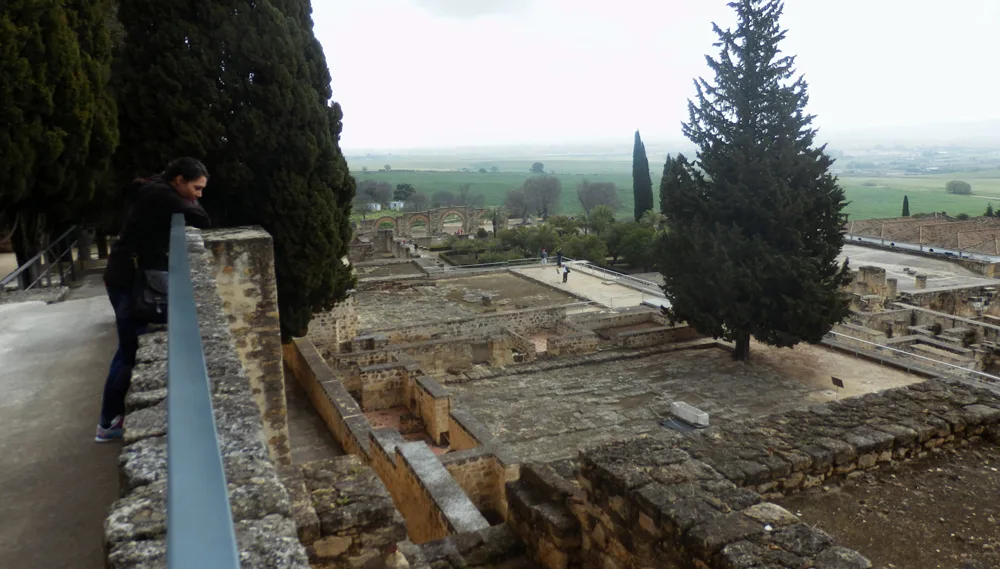
A long-lost city waiting to tell its story
This is the story I’m writing about, hoping it will inspire you to enjoy Medina Azahara as much as I did.
Sometimes, we just need that precise bit of information to make us aware of the value of things in front of us.
Other times, it’s about that quiet moment when something clicks, and the puzzle comes together.
This second part is all you. But I can help with the first one!
So, let’s dive in! Shall we?
The history of Medina Azahara
Settled at a short distance from Córdoba, Medina Azahara emerged in the 10th century as the capital of Muslim Spain. It was a palace city for the caliph Abd al Rahman III, one of the most powerful rulers of the Middle Ages.
But soon after, like fulfilling a curse, war destroyed this Andalusian wonder. History forgot about it, and for nearly 1000 years, nobody remembered its former glory.
Not until 1911, during the reign of Alfonso XIII, did the first official archeological excavations take place. They meant to reveal the truth about the site that had remained buried in the mountains for so long.
Archaeologists had their suspicions. However, what they found went beyond all fantasy. And so, the splendid city of Al Andalus recovered its identity and the right to tell its story.

Madinat-Al-Zahra: a city of legends
Medina Azahara is a place where history and legend intermingle. Writers such as Ibn Arabi (1165-1240), Al Idrisi (1100-1165), and Al Maqqari (1578-1632) transformed even its very foundation into myth.
They speak about the limitless devotion that Abd al Rahman III had for his favorite wife, Az-Zahra (the bright). She wasn’t from Córdoba, but a northern place (maybe Navarra) surrounded by misty mountains.
The caliph was madly in love and did everything to please her. When she told him she dreamed of a city filled with wonders, he began building one without delay. A capital named after her that would have her statue presiding at its entrance: Madinat Az-Zahra.
He hired the finest artisans, acquired the most valuable materials -wood, marble, and tiles- and created delightful gardens inhabited by exotic flowers and birds. Expensive fabrics and furniture from the Eastern edges of the Mediterranean adorned her chambers.
The radiant city of Az-Zahra
But even though she lived in the most breathtaking place the world had ever seen, “the radiant” Az-Zahra was always sad. She missed her home and the snowy mountains.
— “I will make it snow for you in Cordoba,” the caliph said.

And so, he summoned an old greenskeeper named Shams, who had helped build Qurtuba’s palaces’ gardens. He proposed covering the surrounding sierras with white almond trees from Murcia’s slopes.
It was an intelligent plan for the almonds blossom between January and March, coinciding with the time of the year when the northerner would see silvery peaks in her homeland.
“So he had the trees cut down and planted fig and almond trees in their place. There never was a more beautiful landscape, especially during the season of flowers and tree buds, there, between the mountains and the plains.”
Ibn Arabi
Alas, Az-Zahra was happy. She finally felt at home in the bright city Abd al Rahman had built for her as a symbol of their ever-flowering love.
The real reason Abd al Rahman III built the “bright city” of Al Andalus
The caliph’s passion for Az-Zahra is beautiful folklore. However, historians suspect a more mundane reason for the city’s construction.
By the beginning of the 10th century AD, the more significant part of the Iberian Peninsula (nowadays Spain and Portugal) had lived under Muslim occupation for nearly 200 years.
A descendant of the Umayyad Dynasty ruled this territory. He came from a proud Arabic lineage that had dominated Greater Syria from its splendid capital, Damascus.
Until they met a tragic destiny…
In 750 AD, Abu-al-Abbas took control of the Islamic empire. He established a new dynasty that would last for 500 years: the Abbasids. Then, in a “red wedding” type of scenario, he invited the Umayyads to dinner and massacred all of them to prevent an unexpected turn of events.
Almost all of them…
Abd al-Rahman I and the Ummayad Dynasty of Al Andalus
Somehow, prince Abd al-Rahman managed to flee to North Africa and avoid dying like the rest of his family.
After some years spent in Kabylie, at a camp of the Nafza Berber (his mother’s tribe), the surviving prince came to the Iberian Peninsula, established an emirate, and announced himself as Abd al-Rahman I. The lord of a new, powerful state named Al Andalus: a prosperous society where three “Religions of the Book” (Muslims, Christians, and Jews) could coexist.
He settled his capital in the ancient roman city of Corduba, which he (and his successors) embellished with one of the finest examples of sacred architecture ever built: The Great Mosque of Qurṭuba.

It was a period of enormous religious and political upheaval in the Muslim world. Al Andalus became a refuge for people who desired to practice their beliefs freely. And more than that: it was a center of knowledge that welcomed intellectuals and artists from across the Mediterranean Sea.
But during all this time, the Andalusian Islamic territory had only been an emirate. A form of government dependent on some aspect (mainly the religious one) of the Caliphate of the East, ruled by the Abbasids from Bagdad.
A rising capital for a new Caliph
However, in 929, that swiftly changed. Abd al Rahman III proclaimed himself caliph and emir of the faithful in a politically and religiously independent state. He wanted no association with the family that had brutally murdered his ancestors.
More than anything, he desired a power overturn. To make Al Andalus the center of the Muslim empire. Or, as Medieval chronics would say, to have “the Sun set in the East and rise in the West.”
And so, as was Islamic custom, he founded a new capital to commemorate the event: Medina Azahara, the most brilliant gem the world had ever seen.
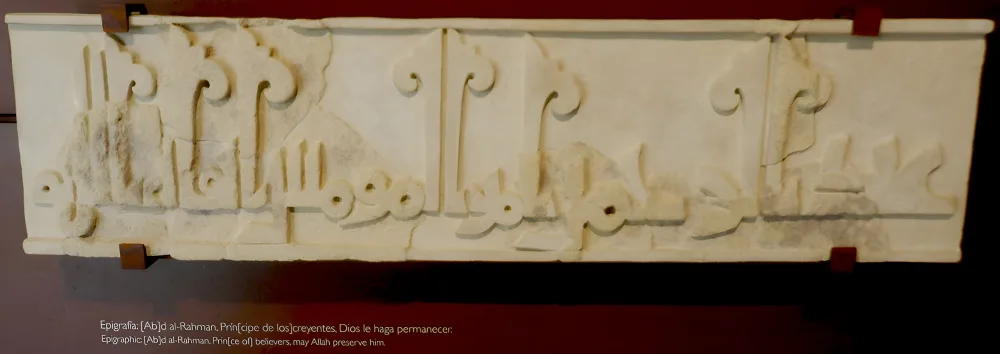
A gem that transformed the Cordovan territory
Al-Hakam II (the successor caliph) continued to develop the city until 976, as part of an intense urbanization process that transformed the Cordovan territory.
This endeavor accelerated the construction of critical facilities that provided the site with water and building materials. And also, various infrastructures allowed it to communicate with Cordoba and other municipalities.
The magnificent urban structure, which once housed 12,000 people, took nearly four decades to complete and required the constant efforts of 10,000 workers (directed by master builder Maslama ben Abdallah).
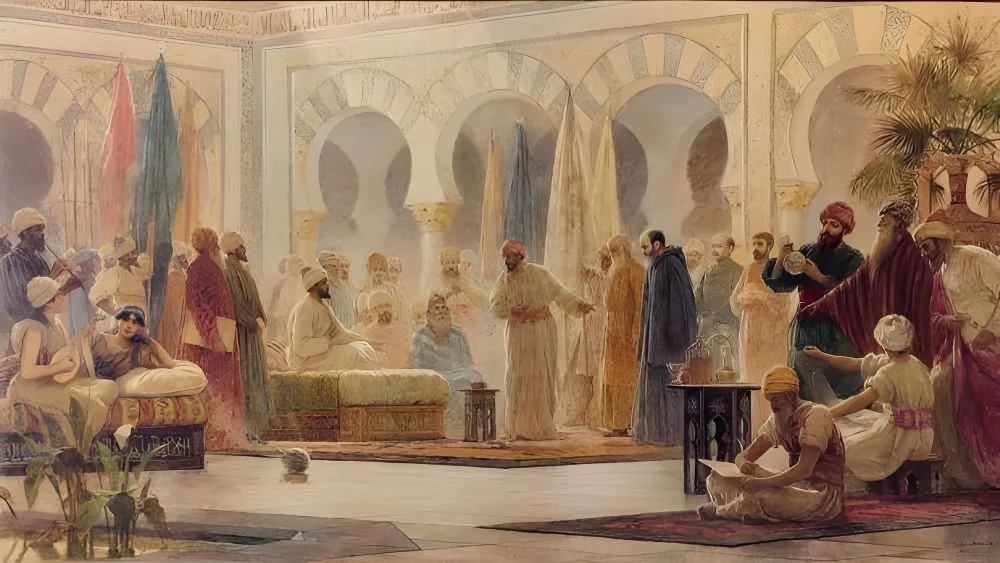
Medina Azahara: a center of the artistic avant-garde
But, in the eyes of the caliph, it was all worth it. Between 946 and 947, the Court, the Government, the House of Coin, and the official Arts Center moved here.
The local workshops created the most exquisite artifacts of all Al Andalus. And for the briefest time, they made Medina Azahara a center of artistic and scientific avant-garde.
Treasures of Medina Azahara
In addition to its architecture, Medina Azahara had a magnificent collection of transportable artworks.
Their beauty and uniqueness made them highly valuable and sought after. As a result, many of these masterpieces now belong to museums and collectors worldwide.
Here are three of the most prominent examples of decorative arts from the Caliphate city of Medina Azahara:
The Pyx of al-Muguira

The pyx of al-Muguira is an urn that belonged to Caliph Abd al Rahman III’s youngest son. Archaeologists found it at the site of Medina Azahara and consider it one of the most relevant treasures of Hispanic Muslim ivory.
Even though the specific purpose of this object remains unknown (it possibly contained perfume or jewelry), there is no doubt about its owner. The inscription on the lid clearly states: “Blessing from God, goodwill, happiness and prosperity to al-Mughīra, son of the Commander of the Faithful, may God’s mercy [be upon him], made in the year 357 [Anno Hegirae].”
Sculpted in 968 by Master Khalaf, the pyx displays extraordinary detail and execution. It shows figures of cavalrymen, lute players, palm trees, lotus flowers, falcons, and lions, among other symbols of power and prosperity.
The Lustreware bowl fragment of Medina Azahara

The Lustreware fragment from Abd al-Rahman III’s palace in Medina Azahara is a one-of-a-kind piece of clay in the site’s context. It was not created in Al Andalus, but brought from the East as a status symbol.
From a technical perspective, this pottery represented the peak of sophistication in the Medieval era. It required three firings: one for the paste, another for the white glaze, and a final one to achieve the metallic luster of the decoration.
The decorative motif of the fragment depicts a camel bearing a standard. Although the meaning of this image is uncertain, some studies relate it to events in the Prophet Mohammed’s life, also shown in similar Abbasid pieces from the 10th century.
The hind of Medina Azahara

The hind of Medina Azahara is a small bronze water spout that decorated one of the many fountains in the palatine city.
It dates from the second half of the 10th century and stands as a masterpiece of Hispanic-Muslim sculpture from the Umayyad Caliphate era.
Now preserved at the National Archaeological Museum of Spain (Madrid), this artwork is similar to two other pieces from the archaeological site. One rests at the Medina Azahara Museum, and the other at the Islamic Art Museum in Doha, Qatar.
A palace-city famous around the world
Medina Azahara’s name became synonymous with splendor. And its premises, a lavish setting for the reception of foreign embassies.
Designed from its inception as political propaganda for the monarch, it aimed to be an earthly paradise of unimaginable beauty. A place that would stun anyone who dared to look at it.
And many did: delegations from North of the Iberian Peninsula, the Roman-Germanic Empire, the Byzantine side of the world, or North Africa wandered in awe over Medina Azahara.
They held the city so dear in their memories that soon, everyone heard amazing stories about the bright capital of the Caliphate of the West.
Why Medina Azahara was destroyed and forgotten
However, at the start of the 11th century, something terrible happened. It is what the Arabics call “Fitna”: a period of instability and civil war that led to the fall of the Cordovan Caliphate and the rupture of Al Andalus into small kingdoms.
And so, Medina Azahara was attacked, looted, abandoned, and turned into a quarry. It was a symbol of the Ummayad Dynasty and a reminder of the illegitimacy of the new rulers that gained power.
“With this ruin, that carpet of the world was folded, and that beauty that had been the terrestrial Paradise was disfigured.”
Ibn Hayyan
Gradually, its existence fell into oblivion. And so, in the 17th and 18th centuries, no one imagined the ruins buried near Cordoba had once been the splendorous city of the caliphs.
No one but a few History students suspected it…

The rediscovery and archaeological excavation of a long-lost gem
During the Middle Ages, everybody thought the ruins abandoned in the mountains were Roman: the Old Cordoba, which had been moved eastwards due to sanitary issues.
Nevertheless, humanists from the 17th century like Pedro Diaz de Rivas realized something else. There were so many Roman remains in the actual Cordoba, that the settlement must have had a Latin heritage. Córdoba had never moved.
This notion led them to believe that hiding underneath what people called “Old Cordoba” was nothing else than Abd al Rahman III’s legendary Muslim castle. Despite the evidence, the argument continued for hundreds of years.
Only in 1911 did the archaeological excavations that confirmed this theory begin. A process of restoration and study that continues to this day, revealing secrets of a bright age and completing a puzzle shattered by History.
Although the progress is laborious and challenging, the current results show what Medina Azahara must have been at the zenith of the Caliphal Era.
The archaeological site of Medina Azahara
Medina Azahara was a fortified city with an area of 112 ha (1.5 km long by 0.75 km wide // 9,3 miles long by 0,46 miles wide). It contained three terraces reflecting the social pyramid of the Umayyad world in its layout.
- The upper terrace housed the caliph’s palace north of the site.
- The administration and residences of the high court officials have their place in the middle esplanade.
- The lower one holds the medina itself: where ordinary people and soldiers lived and where the mosque, markets, baths, and communal gardens were.
The upper part of the city terraces was a fortress made of two different spaces: one for public activity (reception halls) in the East and the other for private life (residences) in the West.

Currently, just 10% of the walled center has been excavated, with practically all efforts concentrated in the alcazar‘s central core (the fortified castle).
In recent years archaeologists have been exploring areas outside the palace complex. This endeavor led to significant discoveries such as a mosque at a considerable distance from the city’s elite district, an Islamic road (one of a kind in Spain), or neighborhoods where the popular class lived.
The beauty of a place declared “World Heritage” by UNESCO
What remains is only a tiny part of what was, but still more than enough to dazzle anyone and draw the attention of international organizations such as UNESCO.
The sustained efforts of archaeologists, art historians, and restorers who studied and recovered the site made it possible for Medina Azahara to join the World Heritage List in 2018.
“This complete urban ensemble features infrastructure such as roads, bridges, water systems, buildings, decorative elements, and everyday objects. It provides in-depth knowledge of the now vanished Western Islamic civilization of Al-Andalus, at the height of its splendour.”
Description of Medina Azahara on the UNESCO World Heritage Convention website
Highlights you cannot miss when visiting Medina Azahara
To solve the riddle of Medina Azahara, you must use your imagination. Indeed, the site’s museography carefully studied its link with Nature in the present display, making this pleasurable exercise easier.
Because Medina Azahara is so much more than beautiful buildings. It is the shade of large trees guarding the mountain slopes, the perfume of the orange flowers in bloom, the oases evoked by the gardens filled with aromatic plants, the light echoed on the water, the song of birds…
It is a harmony appealing to all the senses that the Islamic artists masterfully integrated into the architecture, establishing an exquisite dialog between divine and human creation.
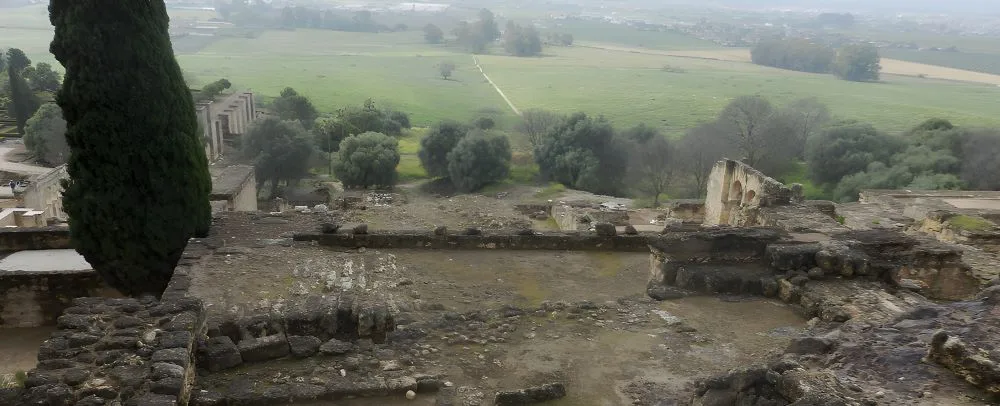
The public spaces representing the Umayyad Caliphate
Thus, the surrounding landscape considerably impacted the city’s layout. Its situation on the Sierra Morena slopes allowed a system in which the physical disposition of each structure revealed its role in the larger urban design.
Suitably, the fortress rises on top of the settlement, symbolizing dominance and authority over the rest of the capital. It kept the caliph’s and crown prince’s palaces and the state’s most important political institutions.
The Rich Hall of Abd al-Rahman III
The Rich Hall of Abd al-Rahman III is the most valuable part of the entire Medina Azahara complex. Uniquely, it stands as the capital’s symbol in terms of refinement and historical value.
Moreover, the fact that it was built in just four years (from 953 to 957) provides a decorative and architectural continuity that allows us to appreciate Al Andalusi classical art at its peak.
![Medina Azahara, Córdoba, Spain [Photograph]. Credit: R Prazeres. Wikimedia Commons. Licensed under CC BY-SA 4.0.](https://itinerartis.com/wp-content/uploads/2021/04/Medina-Azahara-Cordoba-Spain-Photograph.-Credit-R-Prazeres.-Wikimedia-Commons.-Licensed-under-CC-BY-SA-4.0.jpg.webp)
Although the building has a basilica floor plan, it is not a diaphanous space. Instead, it combines segmented zones into a large area split by arcades.
Three longitudinal naves and a transversal portico shape the main hall. Henceforth, blind horseshoe arches crown the apexes of these three naves. The central one accommodated the caliph’s throne, from which he oversaw the palatine ceremonies.
Also, parallel to the core naves and surrounding both flanks of the hall, we find two exterior aisles, each dividing into three cells of irregular sizes.
The caliphs’ throne hall
The Rich Hall was the throne room and the hall’s axis. It housed the most remarkable functions, feasts, festivals, and foreign embassy receptions. Notably, it astonished those who visited the bright capital with its artistic majesty and splendor.
The opulent design of this room highlights the use of the caliphal horseshoe arch with alternating voussoirs in reddish and sandy tones, reminiscent of the Cordoba Mosque.
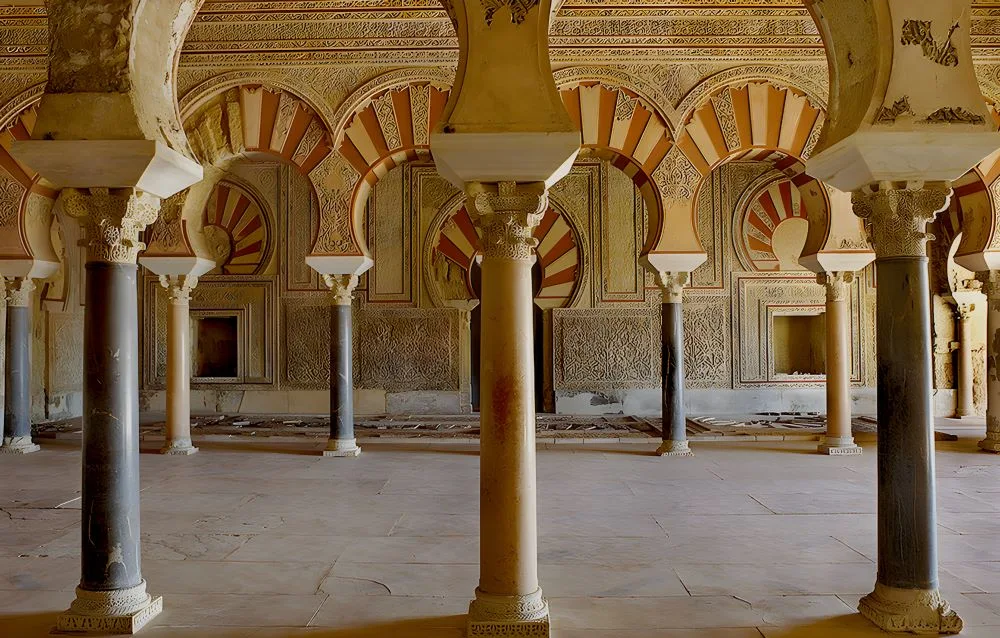
The arcades rest on high-quality marble columns in pink and blue shades, topped by hornet’s nest capitals. This type of capital was developed in Medina Azahara and reproduced in all Al Andalus. It requires a sculptural method that entails the delicate use of the trepan to create stone watermarks of significant artistic impact.
Furthermore, panels carved with cosmic symbolism entirely covered the remaining wall surface. They featured the tree of life, an Ancient Eastern concept. This idea continues on the hall’s wooden ceiling, with painted stars referencing the harmony of the Universe.
The Upper Basilical Hall (Dar al-Wuzara or Dar al-Jund)
Researchers generally identify The Upper Basilical Hall as Dar al-Wuzara (the House of the Viziers) or Dar al-Jund ( the House of the Army), a term medieval texts mention.
It is the city’s oldest reception hall, erected in the 950s as part of a significant architectural program and state reform initiative.
As its name points out, the Upper Basilical Hall is composed of a great basilica-style structure in the north, connected to a vast open area facing south.
The precise function of this massive construction remains uncertain. However, it may have had an administrative or semi-public role, such as a reception hall for diplomats visiting the caliph. More specifically, it was a center where authorities would issue certificates and credentials demonstrating ownership of certain strongholds. And also a place where regular army detachments would be rewarded for their services to state security.
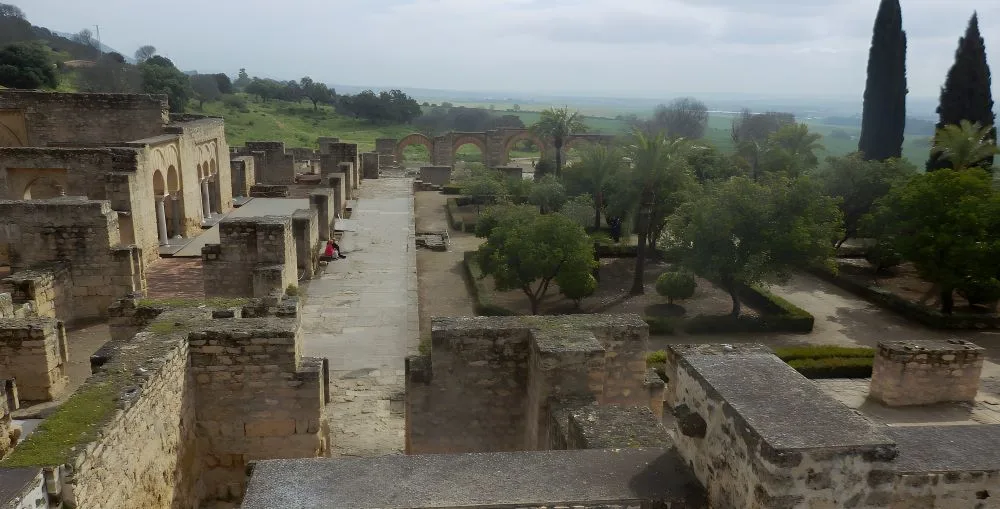
People entering the city reached this location by ascending a ramped street that began near the Bab-al-Sudda gate and rose to the terrace above. This ramp was broad and mild enough for guests to remain on their horsebacks. It even had seats where they could relax while waiting their time to be admitted into the building.
With a capacity of 3000 people, the main hall of Dar al-Jund is the largest interior space ever built in western Islamic palace architecture. It integrated five extensive galleries, arranged side by side and connected by numerous archways.
Contrary to other royal buildings, its decoration was quite simple. The stone plastered had no adornment except a crimson dado near the base. However, decorative furniture such as tapestries and drapes hanging across the arches may have embellished the space initially.
The majestic gates of Medina Azahara
Throughout the Middle Ages, the gates of a walled city were an essential feature of the defensive system. They functioned as a regulated entry and departure point for people, goods, and animals.
Furthermore, they served military, security, health, trade, and tax objectives and also as public information broadcasting platforms. In Medina Azahara, they had an equally vital purpose: they represented power.
The Great Eastern Portico (Bab al-Sudda)
Bab al-Sudda, also known as the Forbidden Gate or Gate of the Threshold, was the alcazar’s symbolic and ceremonial entrance.
It was at the far end of the long road that linked Medina Azahara to Cordoba. As a result, it was the portal through which diplomats and visitors entered the Caliphate capital, meant to amaze and startle them.
Bab al-Sudda had a large portico composed of a lengthy sequence of enormous arches aligned north to south. In the initial layout, this gallery had fourteen feasible arches, most segmental, with the central one being a bit larger and taller, forming a horseshoe.
The decoration of the arcade consisted of white plaster, with the alternating presence of red brick and limestone voussoirs. The gallery was altered throughout time, with the four arches at the north end closed to make way for many chambers and a toilet.
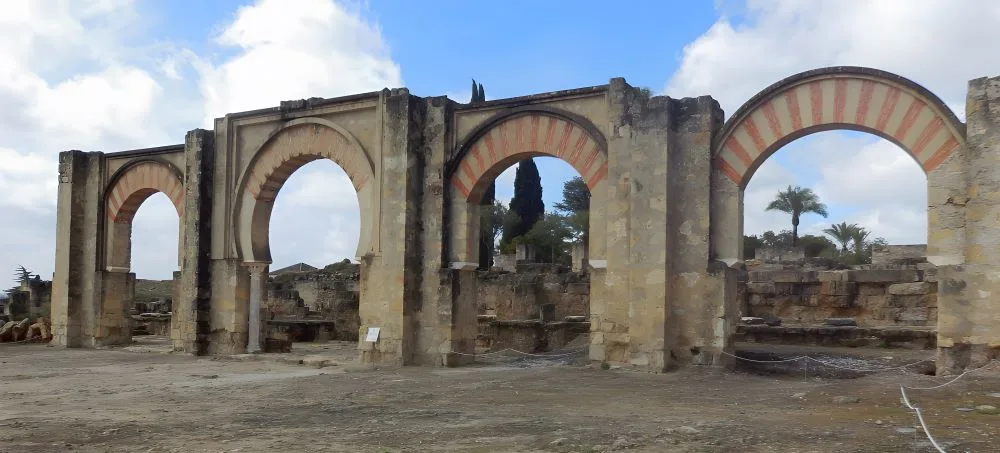
Furthermore, in front of this structure was a colossal esplanade known now as the Plaza de Armas but referred to in medieval texts as ḫaṣṣa (open area).
This space served for public gatherings, military parades, and executions. The caliph could sit and view the events in the plaza below from a platform reserved for him on top of the gate.
The North Gate (Bab al-Jibal)
The northern gate, or Bab al-Jibal (Gate of the Mountains), stands at the city’s highest point, in the center of the north wall, and provides access to the royal quarter.
Given that the Route of the Walnut Trees leads to it, it was the most common entrance gate connecting Córdoba. It is currently the primary entry to the site for visitors and tourists.
The Dar al-Mulk, the caliph’s private palace, stood west of the entryway, while the administrative district and the Upper Basilical Hall (Dar al-Jund) were situated east.
Bab al-Jibal consists of a curved doorway with a defensive tower. Due to centuries of systematic material pillaging, there are few original traces of the northern entrance’s perimeter wall.
Nevertheless, archaeologists could determine that following the curving exit was a chamber with doors facing each other, where a sentry group controlled access from within, providing extra protection. Only two marble jambs survive in their location, pointing at a security mechanism known as “double gate”.
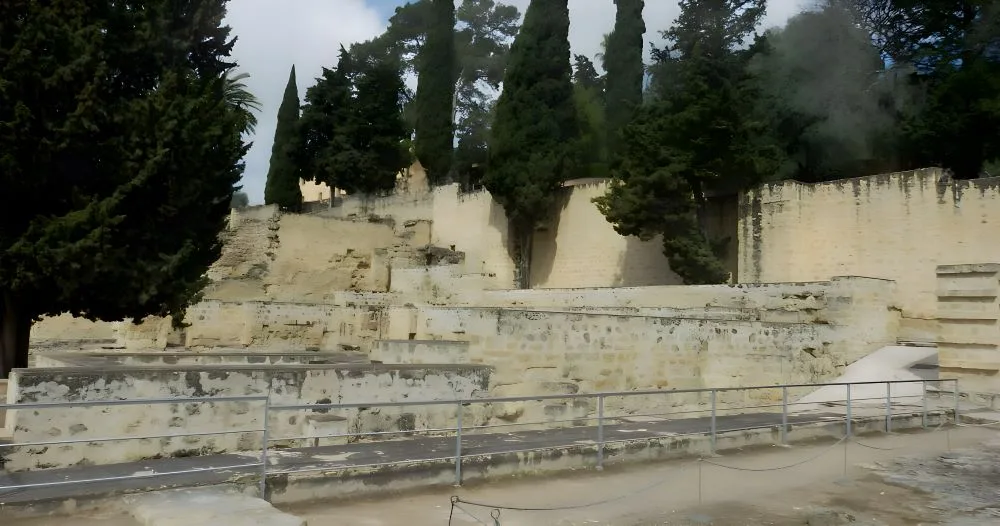
The architecture of the residential spaces in Medina Azahara
All the residential spaces of the upper terraces of Medina Azahara display overwhelming luxury. They were organized into waits (long rooms and patios) that still preserve their structure, colored marble floors, and a good height of the walls embellished with stucco and paintings.
The Royal House (Dar al Mulk)
The Royal House of Abd al Rahman III is the oldest part of the archaeological site. The caliph’s residence was on a rocky promontory to symbolize the monarch’s rule over the surrounding territories.
Historical sources describe it as a dazzling place where Prince Hisham, the successor of al-Hakam II, received his education.
Dar al Mulk’s main building was composed of three parallel, east-west oriented rectangular halls. The first hall might have been an entry lobby; the second was a reception room, and the third was a private space with side chambers that served as bedrooms. The first (southernmost) hall is now gone, while the other two have been partially rebuilt.

A palace with a wide perspective
As you would expect, the best artists in Al Andalus magnificently decorated the Royal House.
They framed tiled geometric patterns on the flooring and enhanced the doorways (some rectangular and some arched) with arabesque designs. Furthermore, they embellished the south-facing façade with three ornate doors and an arcade of blind windows.
The three halls’ entrances face outwards from the palace terrace’s edge. Rather than looking out onto a private garden or courtyard (as was characteristic in many Islamic palaces), they provided views of the far horizon beyond the valley. This disposition, however, finds parallels in Cordoba’s historic Alcazar and ar-Rusafa, an earlier Umayyad mansion retreat in the Cordovan countryside.
The Court of the Pillars
The Court of the Pillars stands north of the House of the Water Basin. Its role remains unknown, but it was possibly used for meetings or councils.
This building is structured around a patio featuring open galleries covered by lintels and supported by matching square pillars. Except for the south part, a sequence of rooms anticipates the halls on both sides of the complex. These spaces were for service housing, water supply pipe passes, and latrines.
Each group of chambers communicates with a gallery through an access door sheltered by horseshoe arches supported by pillars. The parts on the north and east sides are long, narrow, and have little square alcoves at the ends.
Moreover, the two parallel suites on the west side were paved with white marble to distinguish them from the rest of the areas, covered with violet limestone.

A place for assemblies
The arrangement of vast rooms shows that The Court of the Pillars was a meeting place rather than a residence.
Although it originally consisted of two large houses, arranged from north to south, the construction developed over time, and only the ruins of the southern home are visible today.
The open area north of the patio sheltered a small minaret-style stairway that led to chambers of the upper terrace. Under this structure ran a corridor uniting the two abovementioned rooms with the caliph’s private residence.
There was a roman sarcophagus in the courtyard, facing the chambers on the west side. It served as a lovely water basin, depicting the mythical scene of the Hunt for Meleager.
The House of Ya’far
This mansion probably belonged to Ya’far ibn Abdurrahman, a prime minister (hajib) who conducted the works in Medina Azahara’s central pavilion and the extension of the Mosque of Cordoba under caliph Al-Hakam II.
The House of Ya’far accommodates three areas, each centering a patio of a distinct nature: one public, one for personal use, and one for service. The larger southern part housed formal encounters and festivities. It was accessed from the west and built around a square courtyard paved with violet limestone.

Its floor plan was similar to a basilica, with three longitudinal naves communicating through doors topped by horseshoe arches. A transverse nave preceded them: it opened to the courtyard, creating correspondence with the exterior design.
The elegant facade contains a triple horseshoe arcade supported by graceful columns. Skillful artisans embellished it with arabesque decoration featuring plant and geometric patterns, also adorning the entries of the transversal and central halls.
The House of the Water Basin
This mansion rests west of Ya’far house and south of The Court of the Pillars. The building’s core is a central courtyard with a water basin (alberca), which gives it its name.
The house dates from the early days of Madinat al-Zahra, although prime minister Ya’far most likely altered certain aspects of the floor design. Before becoming caliph in 961, Al-Hakam II probably lived here.
The structure is east-west orientated and centered around a square courtyard containing two symmetrical gardens. These spaces originally included low-growing aromatic plants such as lavender, oleander, myrtle, basil, and celery.
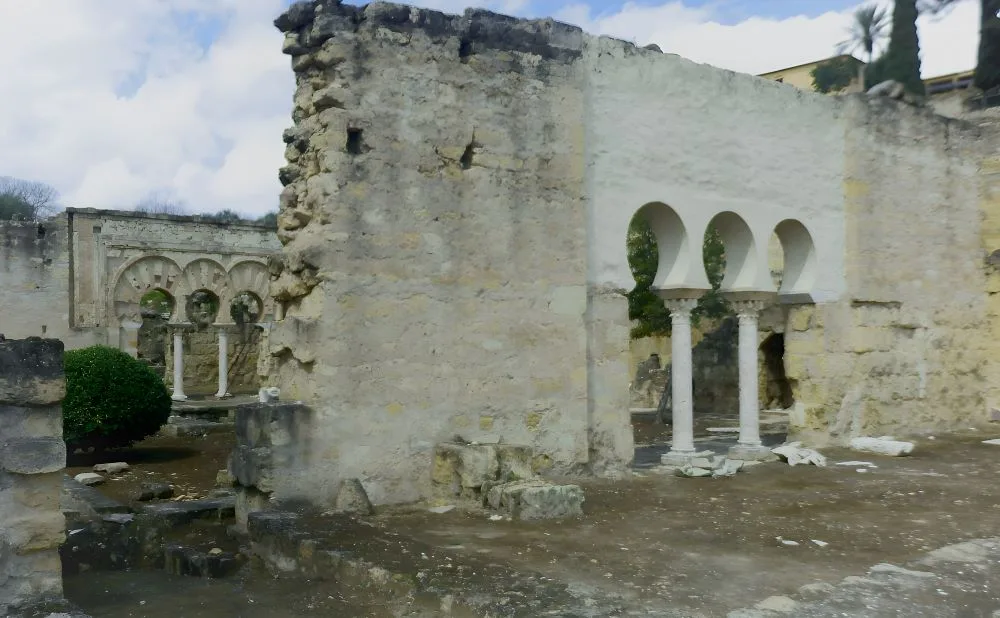
On the courtyard’s west and east sides, we can find two rectangular rooms (one behind the other) with entrances parallel to the patio’s central axis. These main halls are connected by three horseshoe arches framed by an alfiz with carved vegetable decoration, now partially rebuilt.
Archaeologists have also found smaller rooms around the building’s flanks. A private bathhouse or hammam stood beyond the eastern chambers. It consisted of three compartments of varying sizes heated using a standard Roman hypocaust system placed beneath its marble floors.
The luxurious gardens of Medina Azahara
The gardens of Medina Azahara only served one purpose: beauty. They are the earliest western examples of the classic four-part Islamic garden (also known as Chahar Bagh in Persian tradition), a model vastly recreated throughout Al Andalus.
The two extensive greenhouses provided a luxurious scenario for private and public activities. Although they were not on the itinerary of the guests (who arrived at the location through intricate passages), they boosted the magnificence of the ceremonies. From his seat at the significant end of the Main Hall, the caliph could dominate the view of the gardens facing him.
The Upper Garden
The Upper Garden lies in front of the Rich Hall and rises 10 meters above its surroundings on an artificial platform. A broad road encloses the field, and two internal paths divide it into four parts of differing sizes (the northern ones are larger).
Although the original space split into equal quadrants, the east-west path moved south to its current location to make room for the Central Pavilion. This change explains why the garden’s horizontal walk does not coincide with the Lower Garden’s equivalent track nor with the possible position of a pavilion in that area.
The portions are located below the level of the paths to keep the growing flora from obstructing the view. Delightfully, plants that archaeobotanical research traced in the original context (such as myrtle, lavender, hackberry, oleander, basil, jujube, and heather) currently flourish in this zone.
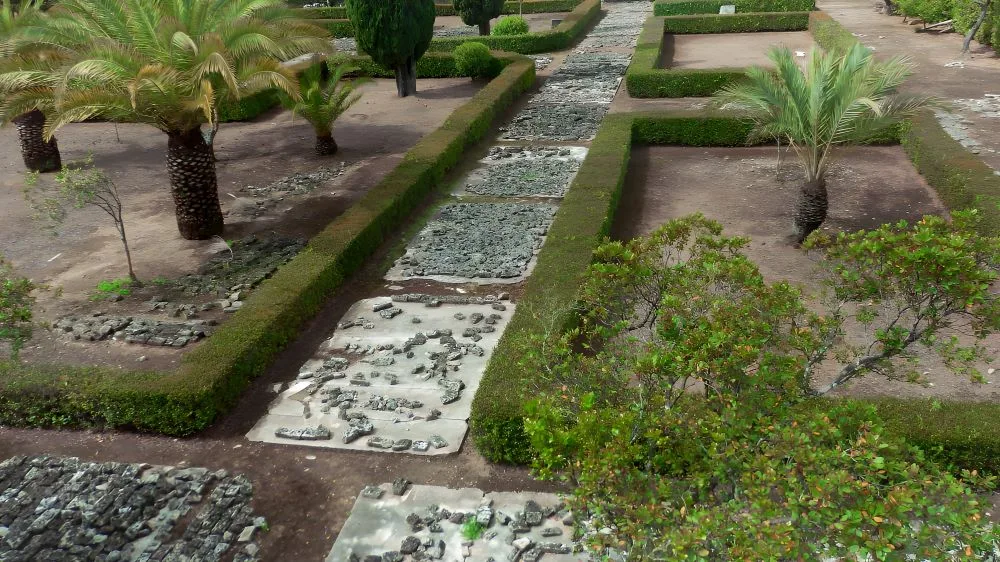
The Central Pavilion
In the heart of the northern side of the Great Garden stood a spanning water basin and a massive complex called “Central Pavilion”, erected in 956 or 957 but poorly preserved.
The Central Pavilion was rectangular: it featured three parallel naves and the main entrance meeting the Rich Hall. The structure rested on a higher platform than the surrounding walkways. It was enveloped on all four sides by small water basins.
The placement of these basins made it so that anybody looking out from within the pavilion would see the sky echoed in the water. In contrast, anyone outside would watch the architecture mirrored in the pools.
Similarly, the pavilion’s position to the Rich Hall meant that the wider northern basin would have reflected both buildings. Because every main entrance opened to water, people inside may have felt that the building was “floating” while gazing out.
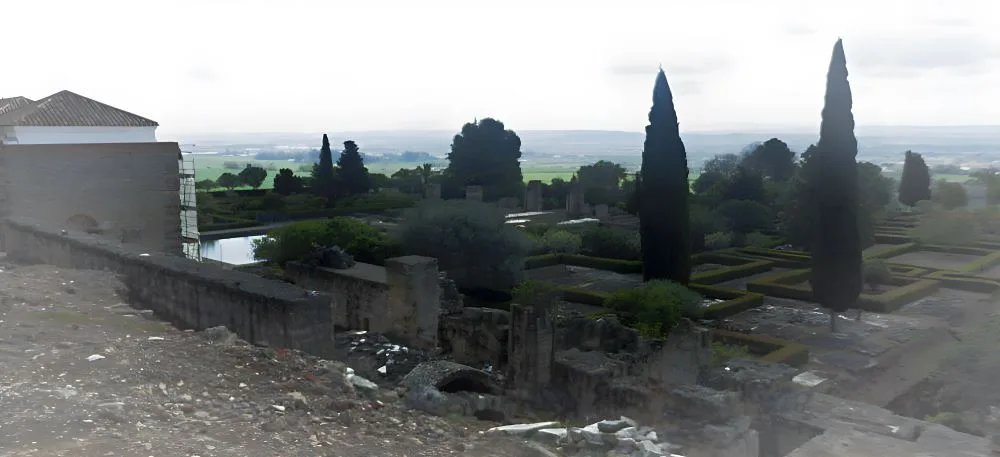
The Lower Garden
The Lower Garden settled on a decreased level, east of the Upper Garden and south of the Dar al-Mulk. Although not completely excavated, it appears to have had an equal four-part distribution, comparable to the original Upper Garden layout.
This greenhouse dates from Medina Azahara’s foundational stage. It was formerly broader, but its width drastically decreased to make room for the Upper Garden.
Like its counterpart, The Lower Garden was enclosed by a wide walkway and split into four terms by two pathways connected in the center. These sunken quadrants displayed aromatic varieties of herbs and shrubs, delighting the senses of Medina Azahara inhabitants.
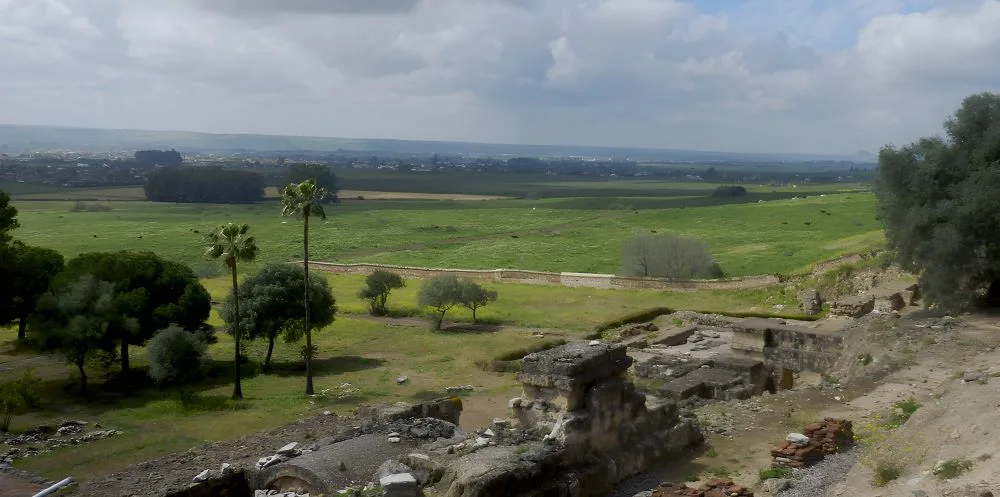
The Aljama Mosq of Medina Azahara
As the capital it was, Medina Azahara had various mosques. Three of them were neighborhood mosques, where believers could attend every day for multiple prayers. On Fridays, however, they gathered in the city’s Main Mosque, the so-called Aljama Mosque.
This Great Mosque is one of Medina Azahara’s most interesting buildings because of its unifying role and the architectural innovations it introduces. It is the first well-oriented mosque in Al Andalus since its qibla (main wall) points towards Mecca and not towards the South, as in the Mosque of Cordoba.
The plant of the Aljama Mosq of Medina Azahara
Entirely constructed in 944-45 (as the epigraphic remains of the main commemorative stone indicate), the Aljama Mosque displays a rectangular plant formed by three essential elements:
1. An open courtyard (sahn) with covered porches on three sides, where Muslims used fountains for ablutions: the cleansing of body and soul before entering the prayer room.
2. A minaret or tower from which the muezzin called devotees to Jumu’ah (Friday prayer). This square-based minaret that originally stood approximately 20 meters (65 feet) high is the earliest of its kind documented in the architecture of al-Andalus. It is slightly older than the one Abd ar-Rahman III later built for the Great Mosque in Cordoba.
3. The prayer hall (also known as muṣallá) had five naves separated by arcades with eight horseshoe arches perpendicular to the qibla wall. Archaeological evidence has shown that the arches were double-tiered, emulating the same design featured in the Great Mosque of Cordoba. The qibla wall contained an octagonal niche called mihrab that pointed toward Mecca, which Muslims face during prayer.
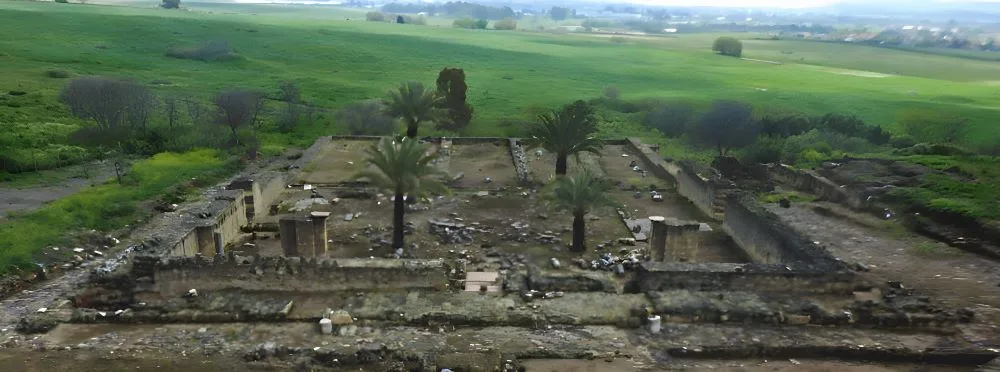
The paving within the Mosque marked the different areas: the sahn was covered in purple limestone slabs; the Maqsura (the space reserved for the caliph) was paved with clay bricks, and the rest of the prayer room was overlapped with esparto mats.
At the end of the caliphate of Abd al Rahman III, a Sabah (secret passage) was added to connect the Alcazar with the mosque’s prayer room, allowing the caliph to enter directly into the Maqsura space reserved for him without having to walk on the street to get there.
The Museum (interpretation center) of Medina Azahara
On October 9, 2009, the Medina Azahara Interpretation Center opened to provide culturally and historically relevant services to the archaeological site.
It is a distinct architectural work that has garnered several honors, including the Aga Khan Prize in 2010, the Piranesi Prize in Rome in 2011, and the European Forum of Museums’ Prize for Museum of the Year in 2012.
The area inside the building serves a variety of purposes. It holds archaeological remains, piece restoration, an auditorium, historical-artistic research offices, and an academic library. Another section provides tourist facilities such as visitor reception, a café, a book shop dedicated to the site, and an exhibition space where Medina Azahara’s most magnificent items are displayed.
The exhibition in the Medina Azahara Interpretation Center
This exhibition area presents the narrative of the place in four themed rooms:
- The first is devoted to the city’s economic, political, and religious backdrop at its founding.
- The second discusses the construction of Medina Azahara, its ramifications, and its relationship with Córdoba.
- The third concerns the residents, separating them into three major groupings formerly part of the royal city: Medina, Mosque, and Fortress.
- The fourth one is about the damage and pillaging that Medina Azahara endured, as well as the excavation work that began in the twentieth century.
Even though this museum is a relatively small facility, it contains a wealth of knowledge. It includes models and informative videos of the site, as well as original works of art that will help you better comprehend Medina Azahara.
Travel tip: The Interpretation Center is where you can buy your tickets (if you haven’t already reserved them online) and catch the shuttle bus to the archaeological site.
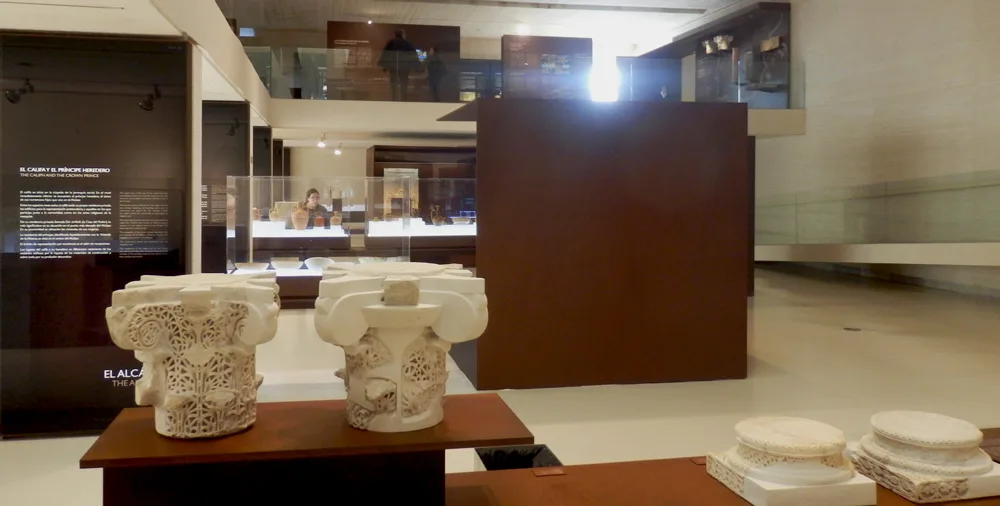
Tips for the visit to Medina Azahara
If you’re interested in Spanish history, visiting the archaeological site of Medina Azahara is a must. This 10th-century palace-city built by Caliph Abd al-Rahman III served as the capital of Al-Andalus. Although time has not been particularly kind to this medieval gem, there are still plenty of ruins to explore. Here are some tips for making the most of your visit:
1. Start at the Visitor Centre
Before heading into the ruins, explore the Visitor Centre. Here you can pick up a site map and learn more about its history. There’s also a short film about Medina Azahara that’s worth watching.
2. Wear comfortable clothes
The archaeological site is quite large, so you’ll be doing a lot of walking. Wear comfortable shoes that allow you to move easily over steep terrain.
Wear a light, waterproof jacket. Remember that Medina Azahara lies at the foothills of the mountains. Therefore the temperature might shift or even rain at any time.
Sunglasses and sunscreen are also a must. Even in winter, the sun in Spain can be very intense. So make sure your eyes and your skin have the protection they need.
3. Pack water and snacks
There are no shops near the archaeological site, so pack your own water and snacks to stay hydrated and energized.
4. Take your time
There’s no need to rush through your visit. Medina Azahara is one of those places where it’s best to take your time and savor everything it offers. That way, you can appreciate all the details of this fascinating city.
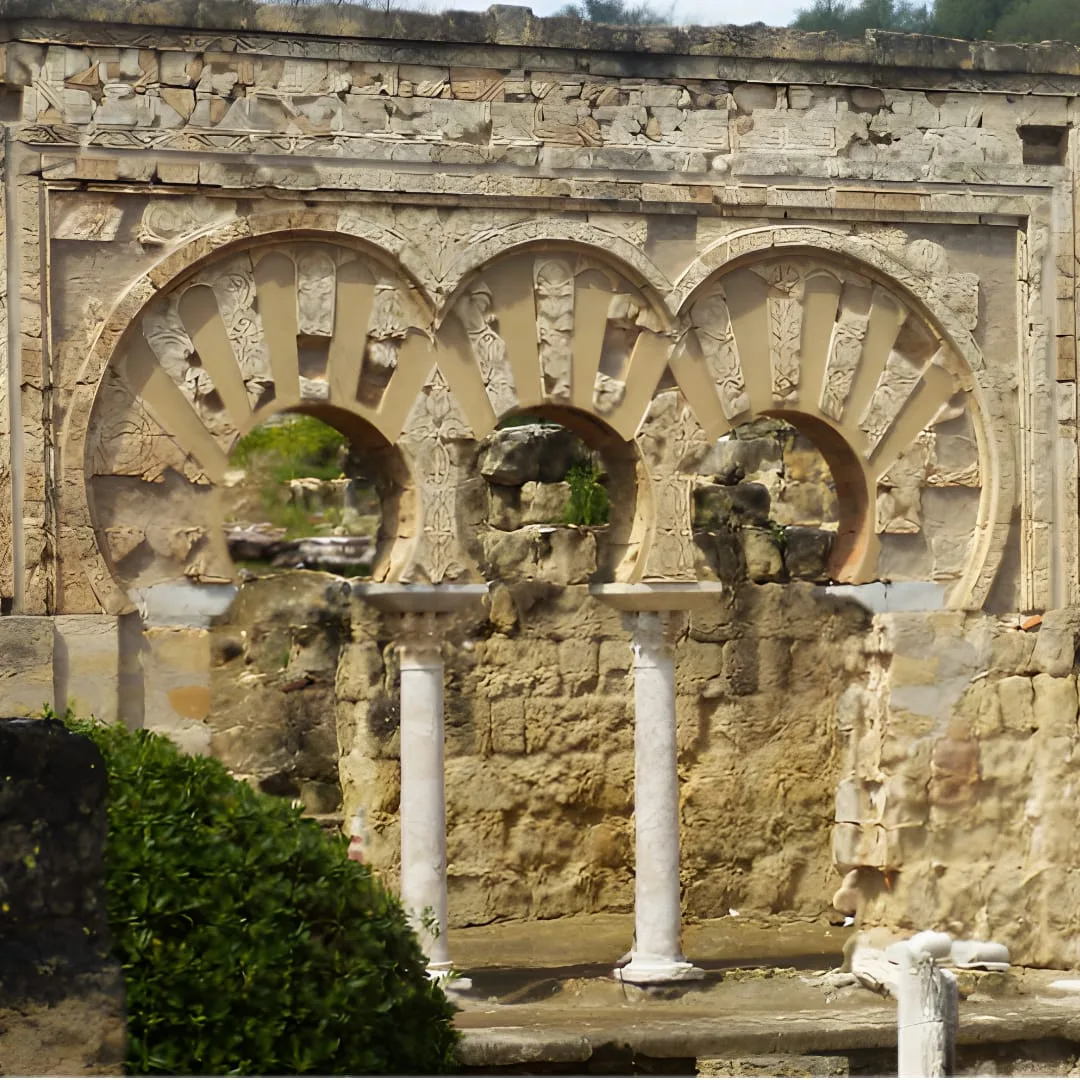
When is the best time to visit Medina Azahara?
There is never a wrong moment to see Medina Azahara. However, I think spring is the best time to visit the location.
If you don’t mind the occasional rain, everything else is perfect. It’s bright, but the heat isn’t as intense as in summer. The surrounding landscape is at its most beautiful stage, with green leaves and blooming flowers. The days are longer than in winter, and so are the visiting hours.
Also, the area is not as crowded with tourists because it is not yet peak season. One can breathe the fresh air and enjoy the site and its relationship with Nature.
Where is Medina Azahara located?
Medina Azahara lies about 8 kilometers (5 miles) west of Córdoba, in the last foothills of the Sierra Morena, on the slopes of the Jabal al-Arus (Mountain of the Bride), facing the Guadalquivir river and orientated north to south on a spur of the mountain range between two slopes.
How to get to Medina Azahara (from Córdoba)?
By car
Follow the Palma del Ro (A-431) highway until you reach the Madinat al-Zahra sign on the CO-3414 road. The road can get tricky, and it’s easy to get lost. If you drive your (rental) car, have a GPS navigation system.
Keep driving to the parking lot of the Madinat al-Zahra Museum, located on the first roundabout, where you must park your car.
Bear in mind that the only way to go from the museum to the archaeological site is by a shuttle bus the interpretation center provides that departs every 20 minutes.
By taxi
Taxis are the shortest way to go from Córdoba to Medina Azahara. They cost between €9 and €11 and take around 8 minutes to complete the trip.
By public transportation
A tourist bus departs Cordoba from Tuesday to Sunday at 11:00, Saturdays and Sundays at 10:00, and 16:30 from Tuesday to Saturday during the summer. You can take this bus from Avenida Alcazar, in Cordoba. It costs about 10 € for a roundtrip.
If you choose this transportation method, you will have approximately 3 hours to visit the museum and the archaeological site.
By booking a day trip to Medina Azahara
You can also book a day trip that includes transportation from Cordoba to Medina Azahara and a guided visit to the archaeological site.

Tickets & visiting hours for Medina Zahara
You can purchase your admission ticket directly at the site’s Museum or book a guided visit in advance.
* Note that groups of more than ten people are required to book their visit in advance and have the option of booking a private tour.
Ticket prices for Medina Azahara
· EU citizens: Free Admission.
· Rest of citizens: 1,5 € per person.
Travel tip: You can also book a guided tour of the archaeological site. This service costs approximately 20 € per adult and 10 € for children (age 5 to 12).
The internal bus to Medina Azahara
The only way to get from the reception center to the archaeological complex is by bus. This internal shuttle bus runs every 20 minutes and costs around 2,5 € per person.
Visiting hours for Medina Azahara (around the year)
*A quick note: Tourist seasons (how cultural institutions program their schedules) do not always coincide with the natural year seasons, although they may overlap for the most part.
- In Winter (from 1st January to 31st March): Tuesday to Saturday: 9:00 to 18:30 / Sunday and Holidays: 09:00 to 15:30. Closed on Mondays.
- In Spring (from 1st April to 15th June): Tuesday to Saturday: 9:00 to 20:30 / Sunday and Holidays: 09:00 to 15:30. Closed on Mondays.
- In Summer (from 16th June to 15th September): Tuesday to Saturday: 9:00 to 15:30 / Sunday and Holidays: 9:00 to 15:30. Closed on Mondays.
* Summer night visits (from July 1st to September 30): Tuesday to Saturday, from 20:00 to 24:00. The night visit only includes the archaeological site (not the museum).
- In Autumn (from 16th September to 31st December): Tuesday to Saturday: 9:00 to 18:30 / Sunday and Holidays: 9:00h to 15:30. Closed on Mondays.
Opening holidays: October 12, October 24, November 2, December 7, and 8.
Closing days: Mondays, 1st and 6th January, 1st May, 24th, 25th, and 31st December.

How much time does the visit to Medina Azahara take?
Even though you can visit Medina Azahara in about 3 hours, the best advice I can give you is to take your time. You can spend the entire morning or even the day exploring Medina Azahara without noticing the hours passing. The museum is a gem holding incredible treasures, and the site is a wonder waiting to be discovered.
Is the guided visit to Medina Azahara worth it?
Another great advice I have for you is to arrange a guided visit. Imagine yourself on an archaeological site surrounded by ruins. I hope this post will help you better understand & enjoy them.
But the experience of hearing someone residing there explaining the history of the place is special and cannot be underestimated. It connects you to the memory of Al Andalus in a way that no amount of written information will ever be able to.
So, if I should visit it again, I’d research this city beforehand. And then, I would let myself be guided through its ruins by someone who knows it like the palm of their hand. Ask them questions that pique my curiosity. And maximize my time discovering the details of Medina Azahara that once made it the brightest gem of the western Muslim world.


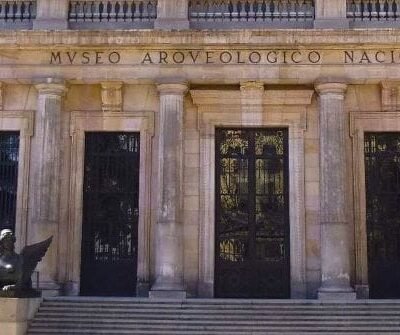

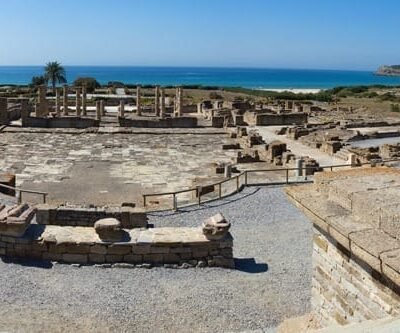
3 Comments
Trine Nohr
Hello
I was searching for more in depth information on the Medina Azahara. This article was in particular appreciated from my part inspiring and preparing me going tomorrow.
Thank you!
Kind regards
Trine
Roberta Darie
Hello Trine,
I’m thrilled to hear that you found the information on Medina Azahara inspiring and helpful for your visit! It’s truly a remarkable site, rich in history and beauty, and I’m sure you’ll find your experience there as captivating as the stories that surround it. If you have any more questions or need further insights, feel free to reach out. Enjoy your journey to this magnificent gem of Andalucía, and I hope it exceeds your expectations.
FJCan
May be the greatest introduction to Medina Azahara.
Thank You